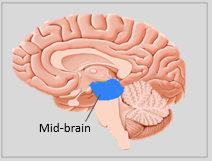
Mid- brain
The midbrain is a structure located between the forebrain (which includes the cerebral cortex and limbic system) and the hindbrain (which includes the cerebellum and brainstem). It plays an important role in the processing of sensory information and in the regulation of certain bodily functions such as vision, hearing, motor skills and regulation of body temperature.
The midbrain is divided into two main parts: the tectum and the tegmentum. The tectum is the upper part of the midbrain and contains the superior and inferior colliculi, which are involved in the processing of visual and auditory information. The tegmentum is the lower part of the midbrain and contains several nuclei involved in the regulation of body functions, as well as nerve pathways important for motor function.
The midbrain is a complex structure that regulates several important bodily and sensory functions, so it makes sense that specific midbrain biomarkers may be useful for diagnosing and monitoring certain neurological diseases.
Some studies have suggested that measuring the size of the midbrain could be a useful biomarker for diagnosing certain diseases such as Parkinson's disease. Indeed, brain imaging studies have shown that the size of the midbrain is significantly reduced in patients with Parkinson's disease compared to healthy individuals.
Other potential biomarkers of the midbrain include levels of specific proteins in cerebrospinal fluid (CSF) or blood. For example, studies have suggested that levels of the protein alpha-synuclein in CSF may be a useful biomarker for diagnosing Parkinson's disease and tracking its progression.

